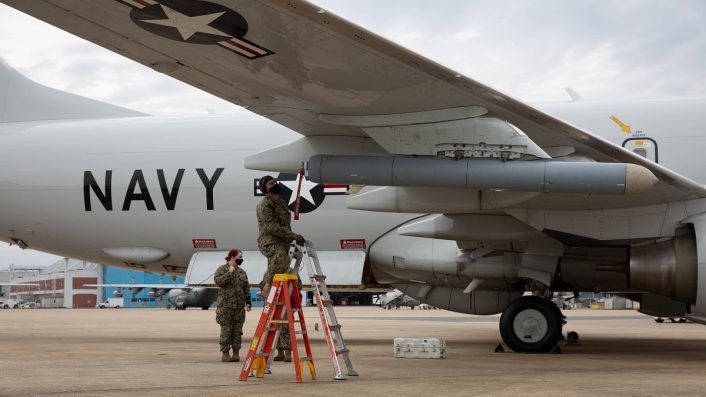Destined for the P-8 Poseidon, the contract will see three low-rate initial production units constructed at a cost of $40.7 million.
The contract, under the direction of Naval Air Systems Command (NAVAIR), will see work divided between BAE Systems’ facilities in Nashua, New Hampshire (91.5%) and Austin, Texas (6.3%) alongside Naval Air Station Patuxent River, Maryland (2.2%). NAS Patuxent River, commonly referred to as Pax River, is the headquarters of NAVAIR and is a major U.S. Navy hub for aircraft trials, testing, and evaluation.
BAE Systems’ Advanced Survivability Pod (ASP) was chosen by the U.S. Navy in 2021 for a demonstration contract. An engineering and manufacturing development (EMD) contract followed in June 2024. ASP is an electronic warfare (EW) pod that the company says fuses radio frequency (RF) and electro-optical/infrared (EO/IR) threat detection and incorporates high performance RF countermeasures. It also carries an AN/ALE-55 Fiber-Optic Towed Decoy, the same used by the F/A-18E/F Super Hornet.

These will add to the P-8’s ability to disrupt and defend against hostile radar systems, sensors, and weapons. As a podded capability, it will likely operate in a supplementary role in addition to the aircraft’s built-in AN/ALQ-240(V)1 electronic support measures system, AN/ALE-47 countermeasures dispenser, and AN/AAQ-24 Directed Infrared Countermeasure System (DIRCM).
Although the pod has been chosen specifically for the P-8 Poseidon, BAE Systems advertises the pod as being suitable for a variety of high value airborne assets (HVAA) including the C-17 Globemaster III, C-130 Hercules, KC-135 Stratotanker, and KC-46 Pegasus. Its casing is reportedly based on that of the AGM-84 Harpoon, which would make carriage on the P-8 Poseidon in particular a simpler task than an entirely new design.
Protecting HVAAs in the modern battlespace is a major concern as access to capable anti-aircraft weaponry becomes more common among both state and non-state actors. In addition, long range air-to-air missiles like China’s PL-17 and Russia’s R-37 can place aircraft in harm’s way even hundreds of miles from the notional front line.
These missiles are seen as answers to the U.S. Navy’s prized AIM-54 Phoenix, but the long range capability of the Phoenix was lost with the retirement of the F-14 Tomcat – this is only now being regenerated with missiles like the AIM-174B.
Don Davidson, director of Advanced Compact Electronic Warfare Solutions at BAE Systems says that the ASP is “a very capable system using proven technology to defend against air-to-air and surface-to-air guided threats.”
The use of modern, open architectures is intended to allow the ASP to be easily configured and upgraded with emerging technologies or customer specific equipment. Presumably in the near future this will include the Dual Band Decoy that is in the works to replace the AN/ALE-55.
Probing the Frontlines – Multirole Poseidon
The appearance on flight tracking websites of at least one U.S. Navy P-8 Poseidon operating in the Baltic Sea, near the Black Sea, or in the Eastern Mediterranean, is now such a common occurrence that these activities are rarely noted. With their Raytheon AN/APY-10 surveillance radars and Wescam MX-20HD electro-optical/infrared (EO/IR) camera turrets the maritime patrol aircraft are potent general surveillance assets.
Apr. 8, 2025#Keflavík, Iceland ==> #Baltic Sea#NoCALLSIGN #AE6815 USN P-8A Poseidon pic.twitter.com/1jrQ5N24yx
— Heo TaeJin (@AIYeyENGDdJkjTr) April 8, 2025
This capability can be boosted even further by the role-fit AN/APS-154 Advanced Airborne Sensor (AAS). AAS was developed by Raytheon as a successor to the AN/APS-149 Littoral Surveillance Radar System used by P-3 Orions, using a large active electronically scanned array (AESA) radar mounted in a ‘canoe’ under the fuselage. When in operation, the assembly is lowered by several feet from the aircraft.
2025.04.18
AN/APS-154 Advanced Airborne Sensor (AAS)
P-8 169569#RJSM pic.twitter.com/8SNcjCcVaW
— ポテッタン (@potettan620) April 18, 2025
Using synthetic and inverse synthetic aperture radar techniques, the AAS can allow a P-8 to create extremely detailed 3D maps of locations from a standoff range. This is paired with a moving target indicator, which helps to clearly identify moving targets against clutter picked up by the radar. In this aspect, a P-8 equipped with AAS is in many ways a successor to the now retired E-8C JSTARS with the added benefit of 360 degree coverage, rather than being restricted to either port or starboard.
It is not known how many AAS pods are in active use, but it is clearly a high-value capability that would have an abundance of utility monitoring activity by opposing forces in Europe, the Middle East, and the Indo-Pacific. However, owing to changing U.S. Government policies, at least two AAS equipped P-8s were withdrawn from the European theatre in March to redeploy on missions monitoring the U.S.-Mexico border.
Today, AAS equipped P-8A Poseidons 168996 and 169554 were removed from their ISR duties at NAS Sigonella.
They are now in the US, at Portsmouth. They will then move to their bases to start their new mission of US Border ISR soon. #B1E7A1 #AE67A8 #AE57C1 #AE5F43 https://t.co/hhmjzVVi4i pic.twitter.com/oJ0QHyxHFZ
— 𝙎𝙍_𝙋𝙡𝙖𝙣𝙚𝙨𝙥𝙤𝙩𝙩𝙚𝙧 (@SR_Planespotter) March 8, 2025
The AAS has not been exported to other P-8 operators, and it is possible that the U.S. is reluctant to allow such an export at least to some nations. Instead, international P-8 users may be able to take advantage of the new Multi-Mission Pod (MMP) which is designed for the carriage of a varied range of sensor payloads. This could include electronic intelligence (ELINT) and signals intelligence (SIGINT) hardware as well as radar systems.
As the P-8 continues to evolve more and more into a jack-of-all-trades intelligence, surveillance, and reconnaissance (ISR) asset, advanced self-protection capabilities like the ASP gain even more significance. Unlike many traditional ISR aircraft, the P-8’s incorporation of hardpoints and a payload bay could even allow for direct weapons employment on targets (outside of its maritime role) identified by the aircraft, morphing it even further into a viable long range strike platform.
Navy to greatly expand P-8 Poseidon’s mission with new missiles, mines, bombs, and decoys:https://t.co/jhUuvuieBH
— Tyler Rogoway (@Aviation_Intel) February 4, 2020
This would emulate developments made by France with the Breguet Atlantique 2, a maritime patrol aircraft that eventually began to see deployments to landlocked conflicts to leverage its advanced ISR and weapons carriage abilities. Similarly, before its cancellation, the UK’s Nimrod MRA4 was reportedly designed to carry and launch Storm Shadow cruise missiles.
Currently, no international P-8 operator has integrated locally built weapons on the aircraft – instead choosing to acquire already certified U.S. weapons like the Mark 54 torpedo, but it would theoretically be feasible to fit the aircraft with a wide range of guided bombs, missiles, and torpedoes. The UK intends to integrate the Sting Ray torpedo onto its Poseidons, though no announcement has been made regarding the progress of this after 2023.
The U.S. has already begun the testing of some long range capabilities on the P-8, such as the AGM-158C LRASM. Others, like the AGM-88G AARGM-ER, are under consideration. These weapons alone would make the P-8 a formidable standoff strike platform.









